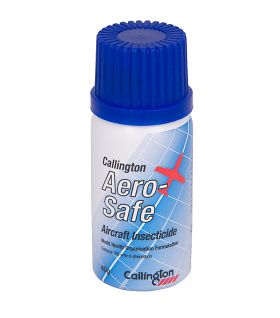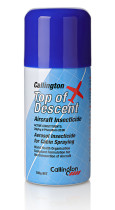Aviation Products // Aircraft Insecticides
- Tested and approved to Boeing and AMS Specifications
- Aircraft approved insecticides
- Non-flammable aircraft insecticide
- Helps prevent the spread of mosquito borne diseases
Description
Callington Aerosafe® Aircraft Insecticde is a non-flammable aerosol insecticide for use inside the cabin of aircraft, after passengers embarkation but before the aircraft is pushed back for departure and on-arrival. The purpose of Callington Aerosafe® (and aircraft disinsection procedures in general) is to help prevent the spread of mosquito borne diseases, such as Dengue Fever, Yellow Fever, Malaria, Chikungunya and Zika. It is also used to reduce the risk to agricultural industries and the environment against exotic pests.
Aircraft approved Callington Aerosafe® effectively kills mosquitoes and other flying and crawling insects. It is to be carried out inside the cabin for 'Pre-departure' or 'On-arrival' spraying methods in accordance with respective national Quarantine regulations.
Callington Aerosafe® Aircraft Incesticde contains a non-flammable propellant and the World Health Organisation recommended active substance of 2% w/w d-Phenothrin.
Approvals
Callington Aerosafe® Aircraft Incesticde complies with the World Health Organisation specifications for aircraft insecticides and has the following approvals:
- Boeing D6-7127 and AMS 1450A
- Australian Department of Agriculture and Water Resources (DAWR)
- New Zealand Ministry of Agriculture & Fisheries (MPI)
- Callington is an ISO 9001:2015 quality accredited company
Application
Aerosafe® spraying method is to be carried out with passengers on board, after passenger embarkation but before the overhead lockers are closed and the aircraft is pushed back for departure or on-arrival for aircrafts that were not disisected before arrival or not disisected correctly or as required as an additional treatment.
Treatment Procedure
TREATMENT PROCEDURE PRE-DEPARTURE
• The treatment is done after passengers have boarded and are seated and all service doors are closed.
• Before commencing treatment, all overhead and sidewall lockers must be opened.
• During disinsection and for 5 min after completion of spraying, the aircraft's air conditioning must be switched off or set to normal flow (not high flow) and the recirculation fans must be on. Hold one can of Aerosafe®, start spraying from the back of the aircraft moving forward, keeping a steady walking pace at a rate of not more than one step or one row of seats per second.
• Can(s) should be directed away from passengers and towards the ceiling and opened overhead lockers.
• When one side of the aircraft is complete, switch aisles, spraying all the way until you reach the rear of the aircraft.
• Spray all galleys, including those on lower levels, and the lift access. Spray all toilets and coat lockers for 2s each. Ensure that the toilet seats and baby changing tables are up and are not sprayed. Spray all crew rest areas, avoiding the bedding, and the flight deck and cockpit for 3s each. Direct the spray away from aircraft equipment, officers and crew.
• Do NOT spray directly on exposed food, food preparation areas or food utensils.
• Spraying of cabins shall be carried out at a standard spray rate of 1g per second and based on a required coverage rate of 35g/100m3.
TREATMENT PROCEDURE ON-ARRIVAL
• Cabin crew should prepare the cabin for disinsection by opening all overhead lockers and requesting all passengers to remain seated.
• During disinsection and for 5 min after completion of spraying, the aircraft’s air-conditioning must be switched off. Recirculation fans may be left on if they are essential for operation of the aircraft but should be set at the lowest flow rate.
• Follow the same procedure as Pre-departure spraying.
Ordering Info
| Item Code | Size | Units per carton |
| 4520/40/1 | 40g | 48 |




